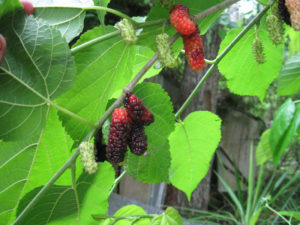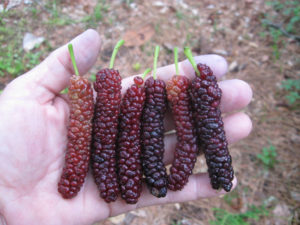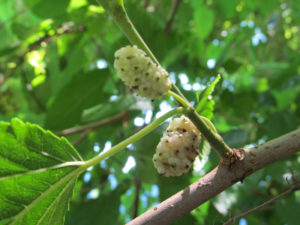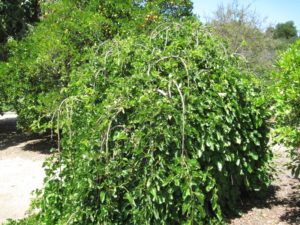[printfriendly]
Mulberry – The First Fruit of Spring

“All around the mulberry bush, the monkey chased the weaselâ€. I don’t know where that monkey and weasel lived but here in Florida, mulberries are big trees. Fast growing, large shade trees, mulberry trees produce a fruit so delicious that a blackberry would weep in envy! Sweet, juicy, and seedless a mulberry isn’t really a berry but a collective fruit. The mulberry is actually a collection of flowers that after they are pollinated swell up, change color and become sweet.

One of the first fruits to ripen in late spring, mulberry trees used to be found in every homestead and farm. Many farmers would plant a mulberry tree in their pastures and chicken yards as a foraging fruit for their animals. Of course, I’m sure the farmer’s wife (and kids) also got some for pies and jams!
Mulberry varieties can be found worldwide; Europe, North and South America, the Middle East, the Mediterranean, Asia, and Africa. The fruit can range in color from red, black, or white and in length from ½ inch to 4 inches long. They are easy to grow and tolerate a wide variety of soils.

Depending on where you live in the US, there are many varieties to choose from that will work from Zone 5 to Zone 10. Illinois Eer-bearing is one of the most cold hardy as it will grow from Zone 5-8. Others like Pandora’s Box Weeping, Wacissa, and Boysenberry will work in Zone 7-10. For folks in Zone 9-10, you can also do the Pakistan and Shatoot. If you want the shade but not the fruit there are several ornamental ones like the Contorted and Ho’O mulberry trees.

For best results, mulberry trees need lots of space, sun, consistent water, well drained soil, and fertilizer. They are easy to grow and will start fruiting as a 1-2 year old. Once a mulberry tree gets tall, the easiest way to harvest the fruit is to spread sheets around the base of the tree and shake the tree. The berries are so tender that they get crushed by hand picking and your hands turn purple unless you wear thin gloves. You’ll always know when the kids have been at your mulberries – the stain takes a day to wear off!
So if you’re looking for a fruiting tree that’s easy and long lived, give the mulberry a try. For folks with small yards, try the fruiting weeping variety, Pandora’s Box.

